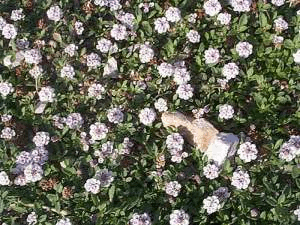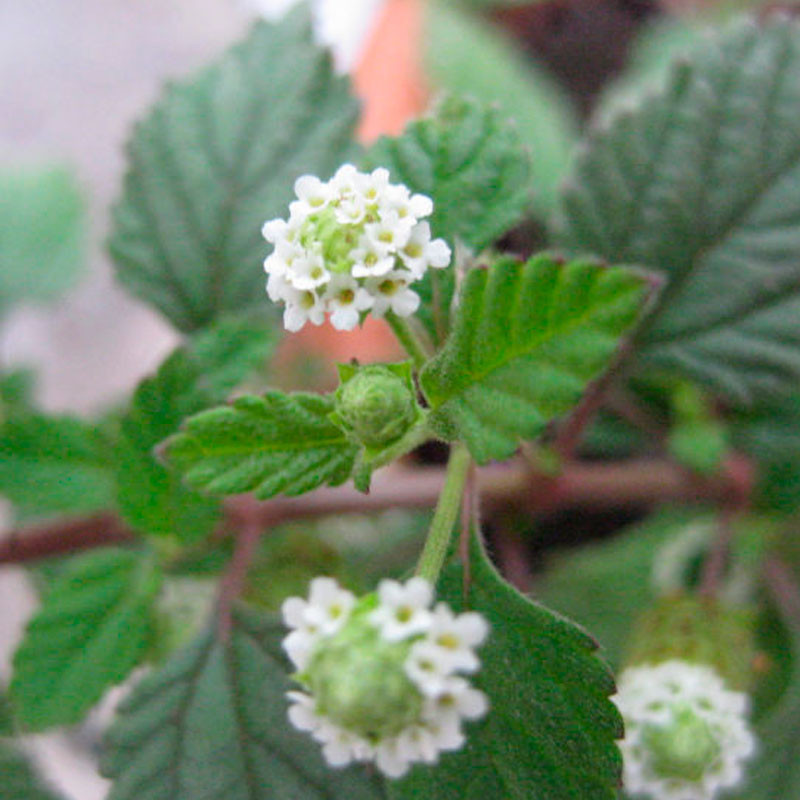Aztec Sweet Herb
Common Names: Aztec sweet herb, bushy lippia, honey herb, hierba dulce, and tzopelic-xihuitl .
Scientific Name: Phyla scaberrima.
Climate: Warm and temperate
Plant Description: It is a perennial herb, erect or sometimes prostrate on the ground, reaching a size of 60 cm high and 100 cm wide, with stems that often root at the lower nodes. The shape of the leaves is ovate to slightly lanceolate and the margins of the leaves are markedly serrated. They have an aromatic and intensely sweet flavor. The color of the leaves can vary between rusty brown, red and green. Clusters of small white flowers are found at the junction of the stem with the leaves. Each flower has four sepals and four stamens. Its aroma is slightly sweet with the smell of honey flowers. The fruits are enclosed in a persistent calyx. The plant has small, sparse and shallow roots that are visually reminiscent of a small lock of hair. It is a tropical species that grows from sea level to 1800 m.
Native in Mesoamerica, Caribbean, Colombia and Venezuela.
Cultivation: It prefers full sun but can grow in places with partial shade. It adapts to any moderately fertile, well-drained soil. It grows in wet scrub and wasteland, wooded riverbanks, pond edges, or in open clearings and pastures.
Propagation is done by seed, by cuttings, or by layering.
Propagation by seeds. The seeds can be spread directly in the field or pre-grown on the windowsill. In the field, the seeds are sown when the soil has stored heat, that is because the seeds only begin to germinate at a temperature of about 20 °C. The first shoots appear after 18 to 40 days. As the plant widens over time, the planting distance should be approximately 60 cm. For growing in the pot, wide and shallow pots are recommended.
Aztec sweet herb is best propagated by layering, where the stolons and leaf nodes have direct contact with the ground so the plant can take a root.
The plant does not need a lot of water once established, but prefers moist conditions. It can't stand drought, but it can't thrive in swampy areas either.
Aztec sweet herb does not have high nutrient needs. It will be enough to fertilize it every two seasons.
Harvest: If the Aztec sweet herb is used as a medicinal or cooking herb, only the leaves and stems are harvested. And the leaves must be collected before flowering. For curative purposes, the herb can be dried. For cooking, however, only fresh leaves should be used, as the sweetness is significantly less when dried.
 Uses: The leaves can be added to salads or used as seasonings. They are often simply chewed by people who enjoy their intense sweetness. The leaves can also be used as sweeteners in teas and other beverages. For healing purposes, the leaves, flowers and roots are used. The most common dosage form is the preparation of a cold water extract. The leaves or flowers should be in the water for two to three hours before drinking.
Uses: The leaves can be added to salads or used as seasonings. They are often simply chewed by people who enjoy their intense sweetness. The leaves can also be used as sweeteners in teas and other beverages. For healing purposes, the leaves, flowers and roots are used. The most common dosage form is the preparation of a cold water extract. The leaves or flowers should be in the water for two to three hours before drinking.
The dried leaves are used to treat coughs, bronchitis, colds, asthma and colic. It has antibacterial properties for the mouth. The infusion of the leaf is taken on an empty stomach as a dewormer. It is used for liver problems, dysentery and problems with delays in menstruation; pregnant women should not take this herb for its abortifacient properties. Its anti-inflammatory and antimicrobial properties are being investigated.
Pests and Diseases: Aztec sweet herb is especially susceptible to rust and mold. Often improper watering or increased humidity promotes the formation of various fungal diseases. In potted crops, adding natural water storage additives like perlite, vermiculite, or zeolite can help.
References:
Anonymous. 1986. List-Based Rec., Soil Conserv. Serv., U.S.D.A. Database of the U.S.D.A., Beltsville.
En Espanol: Hierba Dulce
